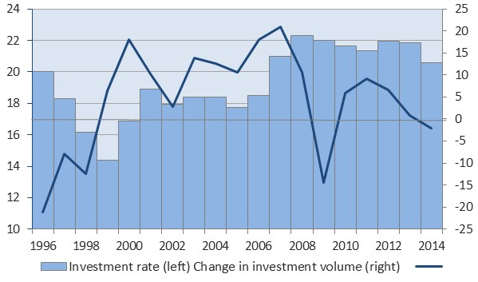BOFIT Weekly Review 23/2015
Russia slashes public investment
Economy minister Alexei Ulyukayev has announced that investment spending from the federal budget would have to be limited over the next few years due to Russia’s frail financial condition. The federal budget framework for 2016–2018 is currently under preparation, including planning of investment outlays. After long negotiations, a working group with members from various administrative branches reached agreement on making 1.8 trillion rubles available for investment this year and next and 1.6 trillion rubles in 2018. This year, about 1.6 trillion rubles (€28 billion) in investments will be financed out of the federal budget. The sum was reduced already in April as part of agreed across-the-board spending cuts for the current year. In addition to cuts at the federal level, regional governments also have to cut back on investment spending.
Federal budget investment spending relative to GDP has fallen every year since 2009, when it amounted to 3.1 % of GDP. Investment spending is estimated to be 2.1 % of GDP this year and 1.5 % in 2018.
Given president Putin’s order that spending on social security and defence remain untouched, the reduction in fixed investment was inevitable. The ministry of economy hopes that the effectiveness of investment will be improved by cutting back on new investment projects and paying special attention to the actual need when choosing new projects. Furthermore, focus must be put on completing the unfinished projects that are at their final stages. This is done to reduce the large number of unfinished projects. Those unfinished projects proved ineffective may face cancellation.
Investment rate (% of GDP) and change in investment volume (% p.a.)

Source: Rosstat
Lack of investment is a big problem for the Russian economy. Fixed capital investment (both private and public) has been inadequate to meet Russia’s needs throughout the post-Soviet era. At its highest, Russia’s investment rate has reached 22 % of GDP. While that is quite acceptable for a developed economy, it is far too low for a county seeking to modernise and diversify its production structures.